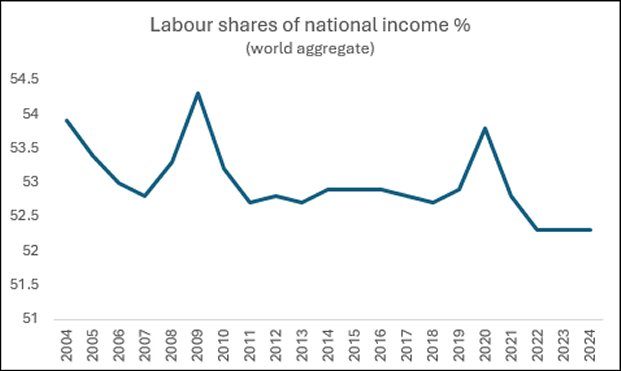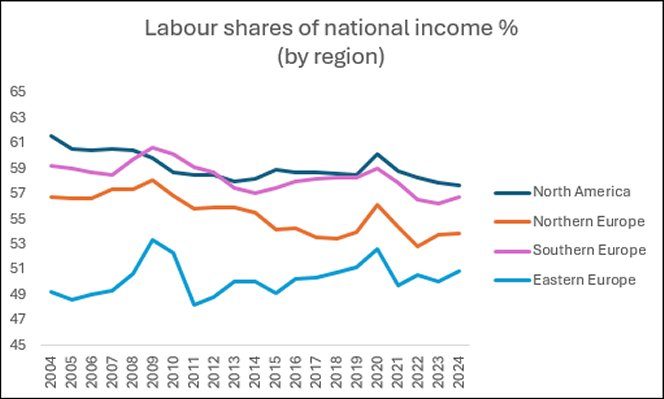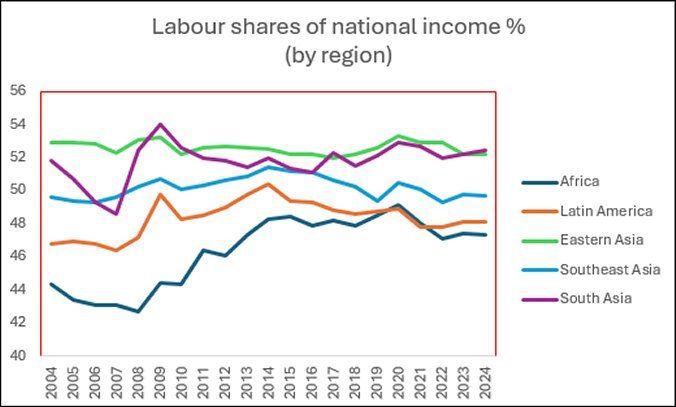From C. P. Chandrasekhar and Jayati Ghosh The latest World Employment and Social Outlook Report (update for September 2024) from the International Labour Organisation highlights some disturbing trends. Importantly, it identifies a significant decline and then stagnation in the share of labour income in GDP, for the world as a whole, in the past few years. This comes as part of a persistent trend of decline in labour income shares, other than spikes in “crisis years” like 2008-10 and 2020-21. (Note that the IO includes income from self-employment as part of the labour share, which is an important point since self-employment is very important, and indeed often dominated total employment, in poorer countries.) Figure 1 shows the trend for the world as a whole, with the share of labour
Topics:
Editor considers the following as important: Uncategorized
This could be interesting, too:
tom writes The Ukraine war and Europe’s deepening march of folly
Stavros Mavroudeas writes CfP of Marxist Macroeconomic Modelling workgroup – 18th WAPE Forum, Istanbul August 6-8, 2025
Lars Pålsson Syll writes The pretence-of-knowledge syndrome
Dean Baker writes Crypto and Donald Trump’s strategic baseball card reserve
from C. P. Chandrasekhar and Jayati Ghosh
The latest World Employment and Social Outlook Report (update for September 2024) from the International Labour Organisation highlights some disturbing trends. Importantly, it identifies a significant decline and then stagnation in the share of labour income in GDP, for the world as a whole, in the past few years. This comes as part of a persistent trend of decline in labour income shares, other than spikes in “crisis years” like 2008-10 and 2020-21. (Note that the IO includes income from self-employment as part of the labour share, which is an important point since self-employment is very important, and indeed often dominated total employment, in poorer countries.)
Figure 1 shows the trend for the world as a whole, with the share of labour income falling by as much as 2 percentage points over two decades, from around 54 per cent in 2004 to just above 52 per cent (estimated) in 2024. The report notes that while this decline “appears modest in percentage points,… the effect is sizeable. This decline represents $2.4 trillion (in constant PPP) in labour income globally in 2024.”
Figure 1

Source for all data: ILOSTAT.
Many factors have been highlighted to explain this longer trend of declining labour shares: technological change causing significant increases in labour productivity, the gains of which were not captured by the workers themselves; trade liberalization leading to greater competition across workers in different locations and associated loss of bargaining power; and other forces. The report considers the impact of technological change, especially greater automation, and finds that “the immediate increase in output is not sufficient to offset the growth in labour productivity; hence, fewer hours of work are utilized in production. Employment also declines, albeit to a lesser extent.”
This is not an unexpected conclusion. However, what may be even more interesting in the report and the associated data (available on the ILOSTAT database) is the extent of variation in labour shares and trends in it, across types of countries and different regions.
Figure shows the variation across countries categorized by per capita income. The difference between labour share of GDP in high income countries and low income countries is the most striking, with a difference of one-and-a-half times on average. At first glance, this may appear to confirm Simon Kuznets argument, made in the mid-20th century, that lower-income countries would also have lower labour shares of income, because they would be more reliant on primary production in agriculture and related sectors, with lower labour productivity. As the sectoral composition of output changed from agriculture to industry and then services in the process of economic growth, both labour productivity and wages would increase and employment would become more formal.
Figure 2

However, that benign trajectory described by Kuznets has been experienced by only a relatively small group of countries over the past century. And it is striking that over the past two decades, the labour share of income in low income countries has barely budged, remaining at 38-39 per cent, while that of higher income countries has come down, from 58.7 per cent in 2004 to 55.4 per cent in 2024. Labour shares in middle income countries did increase between 2004 and 2010, but since then have stagnated or even declined slightly. Clearly, that classic development pattern of increasing labour shares has not existed for a while across all levels of per capita income.
The regional trends provide even more varying trends. Figure 3a provides the trends for some regions of the “developed world”. North America started this period with the highest labour share of 61.6 per cent, but also showed the steepest decline, by nearly 4 percentage points. But labour shares also declined in northern and southern Europe. The contrast is Eastern Europe, where labour shares fluctuated but increased slightly over the whole period, by 1.7 percentage points.
Figure 3a

Figure 3b

Figure 3b provides data on labour shares in some of the major developing regions. The African continent showed a significant rise in labour shares between 2008 and 2014, in tandem with the more rapid growth during that period, but subsequently it stagnated and since 2021 has been declining. A similar trend of rise until 2014 and then decline is evident for Latin America and to a less marked degree in Southeast Asia. East Asia (driven mainly by China) and South Asia have shown broadly stagnant labour shares of GDP over this period.
Within these broad regional trends, some specific national trends are also worthy of note. Despite being significant as major economic growth success stories emerging into upper middle income status, both China and Vietnam have shown stagnation and even slight decline in labour shares of income. However, Malaysia appears to have shown a dramatic increase in labour share of GDP by around 11 percentage points, to 43.4 per cent. And there are several other countries in which labour shares increased, in some places quite significantly and thereby bucking the global trend: Algeria, Botswana, Brazil, Cabo Verde, Costa Rica, Ecuador, Nigeria, Philippines, Russia, Tanzania and Turkiye. Within Eastern Europe, labour shares in Hungary showed a marked decline while those in Poland—seen as another success story—stagnated. In many countries the medium-term trend of rising labour shares until around 2014, followed by declines thereafter.
It is true that such data should be viewed with some caution because of the difficulty of estimating self-employed incomes that are significant in many countries. But the variation across countries, in terms of both level and trend of the labour share, suggests that it is important to look at specific national economic and political trajectories and policies. rather than always looking for the broad-brush explanations.
